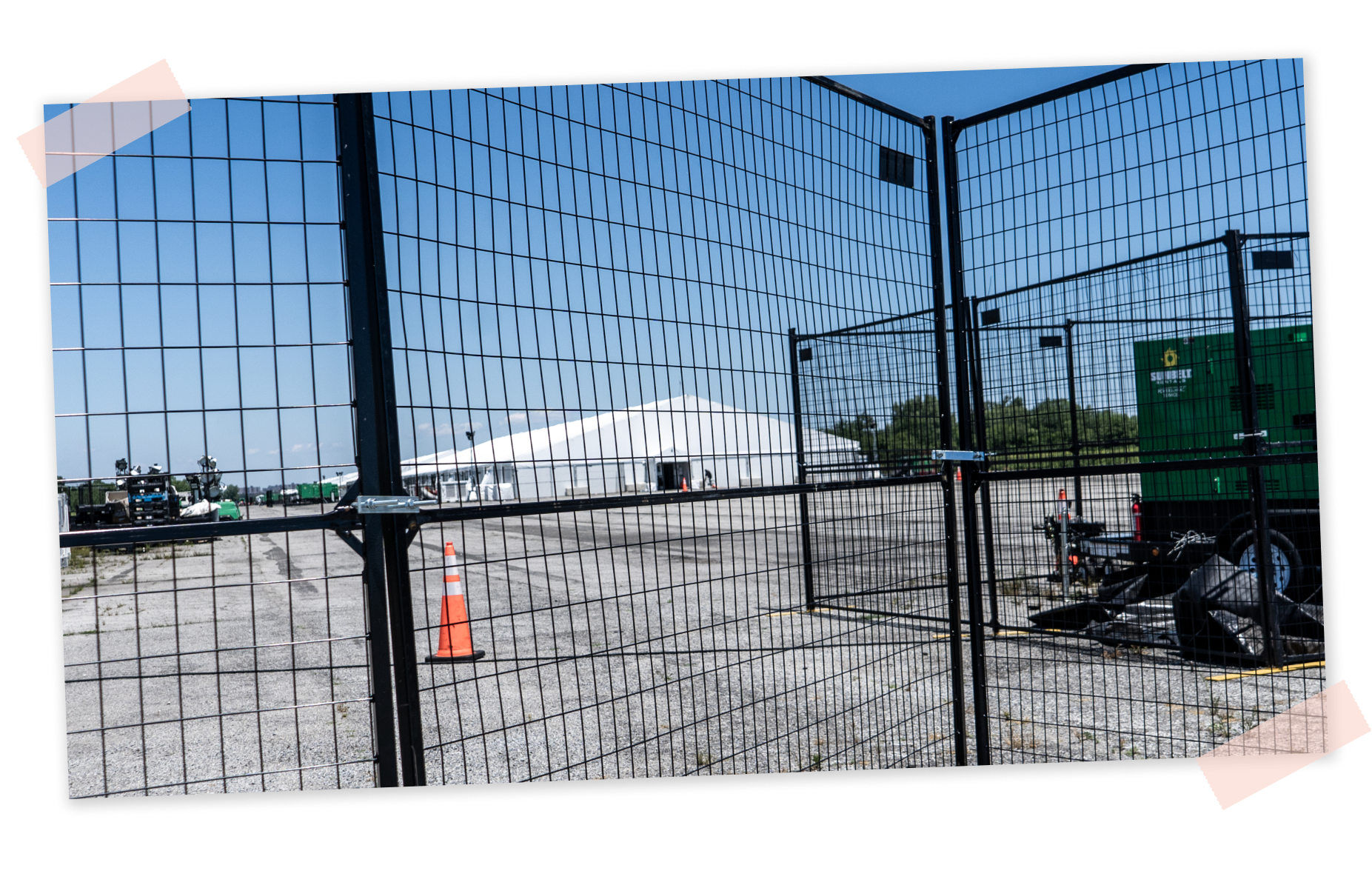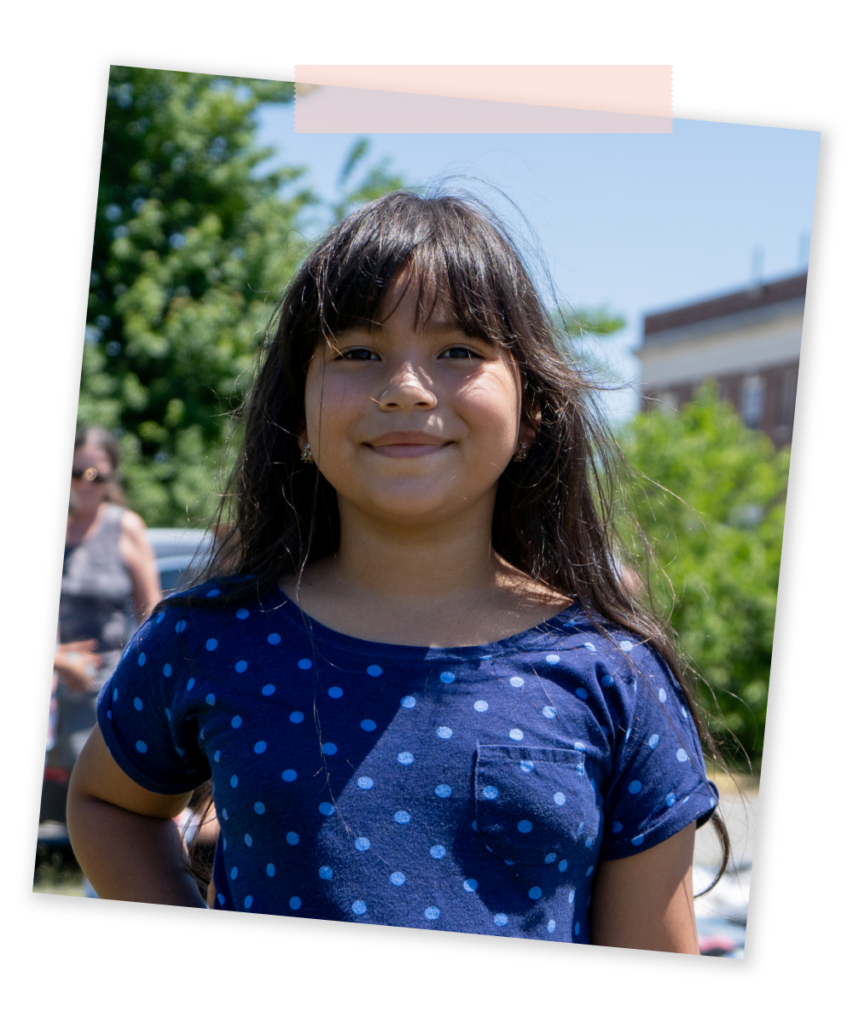Permanent Housing Solutions Can Support Asylum Seekers and Ease New York’s Housing Challenges
Housing pathways for asylum seekers are scarce and confusing. Increasing the housing supply and creating housing opportunities for asylum seekers can benefit all New Yorkers, as well as save taxpayers’ money.
Una versión de este artículo está disponible también en español aquí.
The frosted grass crunched beneath my feet one Sunday in February, during my first visit to Floyd Bennett Field. With every exhale I could see my breath, serving as a reminder that it was 40 degrees outside. The grass was nearly dead: and the surrounding brick and beige buildings looked sterile, militarized, and barren. Located on the outskirts of Brooklyn, long lines of chain-link fences ran between me and several big, white tents, beyond which police officers paced. Though two seasons have passed since then, not much else has changed.
That winter, I began volunteering at this former airfield with a mutual aid group from the nearby neighborhood of Bay Ridge. And, as a policy researcher working on solutions to permanent housing challenges faced by asylum seekers, I wanted to speak directly with those residing in this temporary shelter.

Image caption: Floyd Bennett Field migrant shelter, located in a former airfield, is surrounded by fences. Photo by Rudrani Ghosh.
Fatimah had twenty-seven days to find warm clothes, closed-toed shoes, and a suitcase for her belongings before she would have to leave the migrant shelter at Floyd Bennett Field, and become displaced—yet again.
I heard a voice: “S’il vous plaît, pouvez-vous m’aider?” Please, can you help me? Fatimah1 stood before me in a red t-shirt, worn out jeans, and a pair of flip flops. Gesturing to herself, she continued, “I came three days ago. This is everything I have.” Fatimah had twenty-seven days to find warm clothes, closed-toed shoes, and a suitcase for her belongings before she would have to leave the migrant shelter at Floyd Bennett Field, and become displaced—yet again.
Originally from Guinea, in West Africa, Fatimah is one of more than 205,000 new asylum seekers who have come to New York City since 2022.2 But her experiences of impermanence and displacement in the city are no anomaly. More than 140,000 asylum seekers are no longer in city-run shelters, after the Mayor’s Office began issuing exit notices in October 2023. These notices exclude asylum seekers from the city’s “right to shelter” policy, which guarantees shelter to all domestically unhoused New Yorkers until they find permanent housing.
Typically, families with children and young adults between 18 and 23 years old receive sixty-day exit notices, and single adults receive thirty-day notices. Under the city’s updated guidelines, not all single adults and adult families qualify for re-entry. They must have a disability or an “extenuating circumstance” to qualify, and the latter can range from a severe medical condition to proving that an individual is making “significant” efforts to find alternate housing. Eligibility is determined on a case-by-case basis.
 Families with children are granted re-entry, but may be placed in a different shelter. So far, more than 78 percent of asylum seekers in shelters are families with children, and, nearly one in five children residing in temporary shelters have had their education interrupted due to the exit policy—meaning that nearly 678 children are no longer enrolled in a New York City public school, and 302 children have been transferred to another school. For children who are already grappling with the effects of forced displacement, often serving as their parents’ translators and liaisons, the instability in temporary shelters is further isolating and traumatizing.
Families with children are granted re-entry, but may be placed in a different shelter. So far, more than 78 percent of asylum seekers in shelters are families with children, and, nearly one in five children residing in temporary shelters have had their education interrupted due to the exit policy—meaning that nearly 678 children are no longer enrolled in a New York City public school, and 302 children have been transferred to another school. For children who are already grappling with the effects of forced displacement, often serving as their parents’ translators and liaisons, the instability in temporary shelters is further isolating and traumatizing.
Image Caption: Ariana* is one of nearly 5,700 children living in temporary migrant shelters. Photo by Rudrani Ghosh.
The shelter re-entry process is confusing and arduous, often with long wait times between placements and no guarantee of re-entry. Within a two week period in May, nearly half of the asylum seekers were denied re-entry due to the screening process. These challenges tie into a larger systemic problem that needs to be addressed more urgently with every passing month: New York City’s pathway to permanent, affordable, and dignified housing for asylum seekers is severely limited. Put another way, the city has not provided the vast majority of the 140,000 individuals who were removed from shelter with alternate stable housing.
During my tenure at Next100, I will be exploring innovative and cost-effective policy solutions to the housing challenges faced by asylum seekers, solutions which can increase the housing stock, offer affordable housing to all, and provide asylum seekers with a dignified quality of life in the city.
The available permanent housing pathways are inaccessible and often impractical.
New York City is facing a housing crisis, and the housing pie has shrunk. In 2023, the rental vacancy rate in the city fell to 1.4 percent, with less than 1 percent of availability for apartments costing $1650 or less per month. Creating more permanent affordable housing and codifying asylum seekers’ access to it are the best solutions to address not only the needs of asylum seekers, but also housing instability in the city generally. Increasing the housing supply will benefit all New Yorkers by increasing housing options for voucher holders, lessening the time that people experiencing homelessness have to wait to be matched with permanent housing, and decreasing the rental costs in the housing market overall. In other words, we need a bigger pie, and the ability for all of us to share it.
Increasing the housing supply will benefit all New Yorkers by increasing housing options for voucher holders, lessening the time that people experiencing homelessness have to wait to be matched with permanent housing, and decreasing the rental costs in the housing market overall.
The need for a permanent housing solution for asylum seekers is dire: the systemic conditions that they face in New York are inhumane. Instead of the safety and stability they sought, asylum seekers have been forced to sleep outdoors, inside subway stations, in vehicles, and inside crowded places of worship. Around the same time I met Fatimah this February, seventy asylum seekers were residing in the basement of a store in Queens, crammed into forty beds, after they were forced to leave their shelter in the height of winter.
And now, the city is experiencing an abnormally hot summer. As more than 65 percent of asylum seekers are no longer in city shelters, without air conditioning or respite from the heat, the city must again grapple with how to protect asylum seekers from unsafe, inclement weather.
Asylum seekers also face barriers to housing that domestic New Yorkers do not. They may qualify for housing assistance if they receive “Permanent Resident under Color of Law” (PRUCOL) status. However, the process for obtaining PRUCOL status is long and complex, requiring asylum seekers to show that the government is aware of their residence in the country, and that they are not at imminent risk of deportation. To obtain PRUCOL status, they must secure legal aid, complete an asylum application, obtain receipt notice from USCIS, and apply for PRUCOL.
While PRUCOL technically allows asylum seekers to become eligible for NYCHA, Section 8, or CityFHEPS housing vouchers, there are several barriers: a) not all asylum seekers have applied for asylum, met with legal counsel, or qualify for asylum; b) not all asylum seekers qualify for PRUCOL; and c) there are multi-year wait times through these housing pathways, even if asylum seekers do obtain PRUCOL status. Importantly, asylum seekers undertake these applications while residing in a shelter, and under the current guidelines, the numerous disruptions in their stay make it difficult to obtain appointments, store paperwork, and receive important documents.
Without a straightforward pathway to permanent housing, asylum seekers are vulnerable to continued instability and homelessness.
Most asylum seekers are still not legally eligible to work due to the lengthy work authorization process. As a result, they are unable to work in jobs that pay enough to afford rent, whether in affordable housing or in market-rate housing. Additionally, they are often ineligible for federally funded affordable housing due to documentation requirements. Without a straightforward pathway to permanent housing, asylum seekers are vulnerable to continued instability and homelessness.
By forcing them to be in continued displacement, the lack of stability in the housing process compounds the traumas that many asylum seekers are already grappling with. Most newly arrived asylum seekers originate from South and Central America, the Caribbean, West Africa, and China. Many flee violent persecution, war, and gang violence that has often been caused or exacerbated by U.S. involvement in their homeland. To arrive in America, asylum seekers have embarked on harrowing journeys, walking for weeks across the Darién Gap, risking death along the way. And many have had these experiences while struggling to protect their children and family, and fearing detainment or deportation.
Over time, media and political characterization of newly arrived asylum seekers as a “crisis” has detracted policy attention from the real crisis at hand—the housing shortage.
As thousands of asylum seekers began arriving in April 2022, the city’s efforts focused on temporary and immediate housing needs. Within a year, the city had established shelters and obtained emergency relief funds to provide food and services. But over time, media and political characterization of newly arrived asylum seekers as a “crisis” has detracted policy attention from the real crisis at hand—the housing shortage.
Our housing policy framework needs to shift from “temporary” to “permanent.”
On the day I met Fatimah, a Bay Ridge mutual aid group brought twenty-seven suitcases for distribution. The line, crooked and unending, snaked around the minivan that momentarily stored them. There, I met Julia and her husband, who couldn’t get a suitcase and said they would try again next week before they had to leave. And I met Cristina and Cristina—two friends with the same name—who linked arms and giggled after the last suitcase was given away, though they would have to leave the shelter the day before Valentine’s Day.
Julia and her husband, and both Cristinas, had received exit notices before the city updated its guidelines. The Mayor’s Office does not track what happens to asylum seekers once they leave the shelters, so it is difficult for the city to know whether those who were forced to leave could reapply.
While basic human decency should be the primary reason for improving our response to asylum seekers’ needs, there are several other reasons why such inclusive permanent housing policies will benefit the city.
Video caption: A makeshift distribution site set up by a Bay Ridge mutual aid group in front of the Floyd Bennett Field migrant shelter. Photo by Rudrani Ghosh.
Last year, the Mayor’s Office estimated 25,604 asylum seeker households to be residing in temporary shelters. Permanently housing them using CityFHEPS vouchers, alone, would have saved the city nearly $3 billion annually.
Providing permanent housing to asylum seekers would, for instance, reduce the strain on citywide systems, and drastically improve the quality of life for asylum seekers. According to calculations by Win and New York Immigration Coalition (NYIC), the cost of a CityFHEPS housing voucher is only $72 per night for a family living in a 2-bedroom apartment, compared to $383 per night in an emergency hotel. Last year, the Mayor’s Office estimated 25,604 asylum seeker households to be residing in temporary shelters. Permanently housing them using CityFHEPS vouchers, alone, would have saved the city nearly $3 billion annually.
Critics of permanent housing may argue that the city’s short-term provisions are in fact less costly because they are meant to be used in the short term. However, homelessness is not a short-term issue because root causes like housing shortages, economic depressions, and changes to individual socioeconomic conditions take years to address. The Mayor’s Management Report found that in Fiscal Year 2023, the average length of stay in shelter was longer than a year—one of many indications that housing needs are anything but temporary.
From 2019 through the pandemic, I was a case manager with the San Francisco Homeless Outreach Team. I helped people experiencing chronic homelessness find permanent housing and support services. Unlike New York City’s “right to shelter” laws, San Francisco shelters were available on a thirty-to-sixty-day basis. During my time, I worked with numerous individuals who had cycled through the temporary housing system for years—sometimes decades—waiting for permanent housing. Without stable housing, many returned to the streets and lost their belongings, were assaulted or taken advantage of, and were often harassed by the police.
Working in this role confirmed my understanding that temporary housing like shelters and transitional homes do not systematically address the problem of having nowhere to live, and instead prolongs homelessness.
Providing permanent housing to asylum seekers benefits all New Yorkers, new and old.
One blistering afternoon in April of 2006, in India, my mother received a letter that would drastically alter the course of our lives. Twelve years after her application, she had been granted a visa interview to become a permanent resident in America. During the hottest summer in a decade, my mother moved to California with my brother and me. With no jobs lined up and no financial security, we piled into my aunt and uncle’s home along with their family. When my mother began working as a substitute teacher a few years later, we moved to our first apartment—a roof over our heads and four walls we could call our own. It was short-lived, because my mother’s single income as a substitute teacher was barely enough for the rent and two full meals a day. So, again, we packed up and moved back in with my aunt and uncle.
Still, we were very lucky. We had the privileges of being documented, and a family safety net to support us when we were experiencing housing instability. But, even with support, it was difficult to navigate institutional systems, and the fear of losing our apartment because of financial instability loomed over us.
Asylum seekers in New York City not only have to endure the aftermath of their traumatic journeys, but also have no legal protections, no social safety net, and no institutional support.
Housing is a long-term need—for asylum seekers and for all New Yorkers—but short-term housing solutions are inadequate at addressing these needs. Instead, increasing the affordable housing stock and including permanent housing pathways for asylum seekers can address the long-term housing needs for all New Yorkers, and can ensure that Fatimah, Julia, the Cristinas, and all asylum seekers alike have a chance at a safe and dignified quality of life.
Header Image Caption: Floyd Bennett Field migrant shelter on the outskirts of Brooklyn. Photo by Spencer Platt.
- The names of all asylum seekers mentioned in this piece have been changed for safety concerns.
- According to the Office of the Comptroller, “asylum seeker” refers to “newly arrived migrants who have come to NYC in need of shelter and are seeking asylum or other forms of immigration relief.” This commentary uses the same definition.

